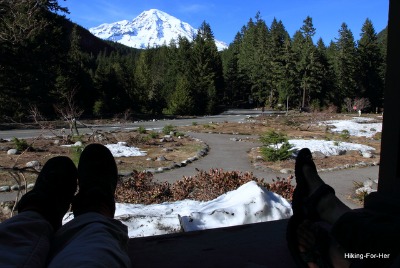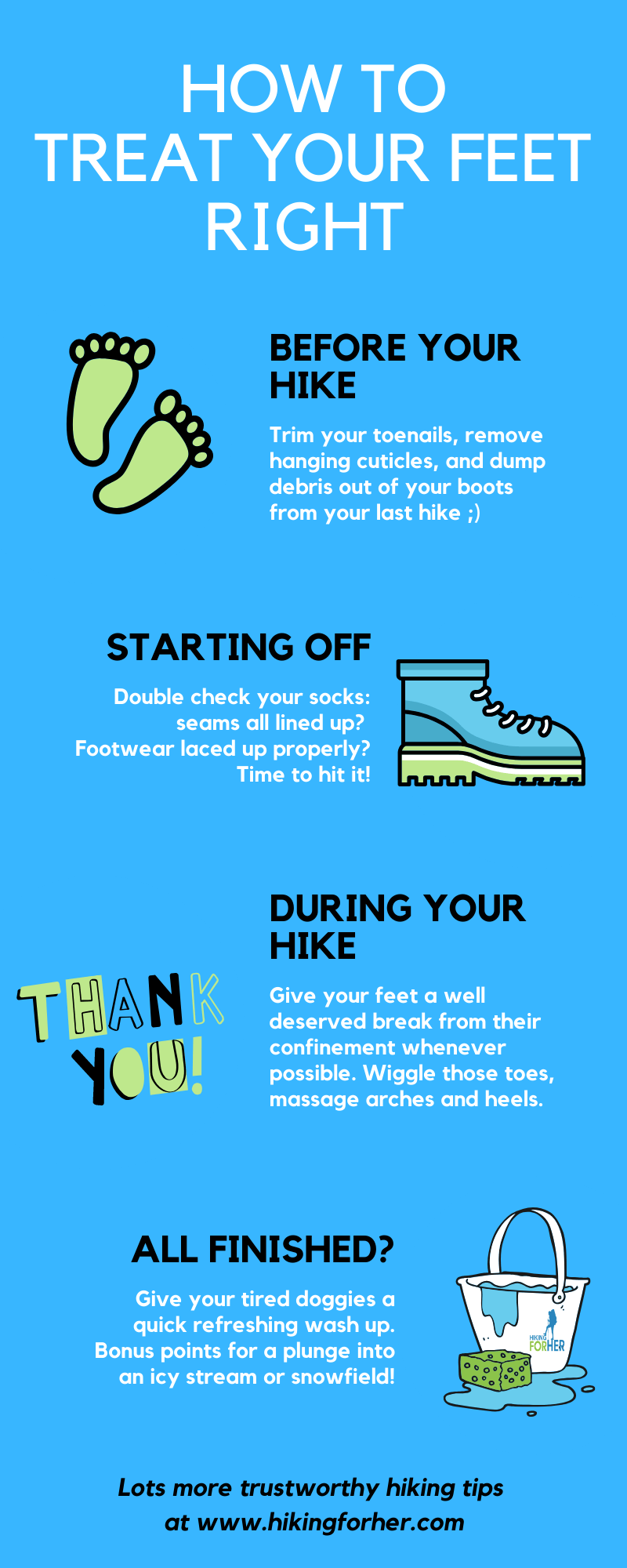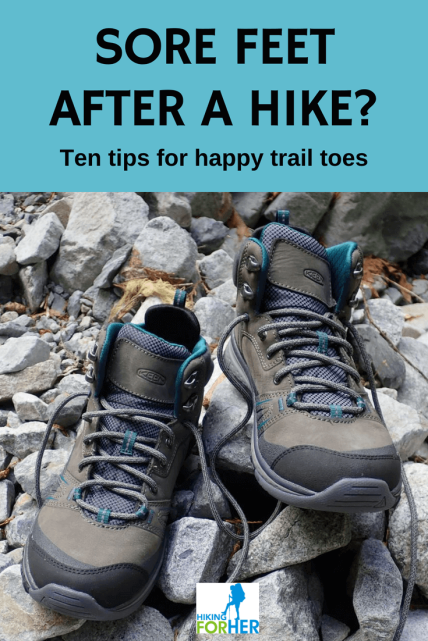
Sore Feet After Hiking?
Get Some Relief With These Tips
By Diane Spicer
Sore feet after hiking?
Foot care for hikers can be a sore subject.
Many people write and ask me the pivotal question:
Why do my feet hurt after hiking?
There are many, many things you should consider to solve the problem of sore feet after hiking.
Rule out the following ten factors, one at a time, until you find relief after putting in miles on the trail: jump links provided to save you time!
- Get your feet checked by a health care professional
- Evaluate weight
- Check your footwear
- Why hiking socks matter
- Hydrotherapy could help with sore feet after hiking
- Foot massage ideas
- Hydrotherapy, Part 2
- Boot inserts and insoles to consider
- Your hydration status is important
- Rule out foot fungus
And if your back is sore, too, read this.
What? Sore knees after hiking, too?
More reading for you!
But only after you read the best tips for dealing with your sore feet.
Ten things to rule out or change if
you have sore feet after hiking
Hunt and peck through these tips for dealing with sore feet.
But please take your time.
Don't overlook anything in your search for the end to your sore feet dilemma!
1. Let's get started with a check up
Get your foot soreness checked out by your health care provider. You want to rule out issues with
- muscles
- bones
- blood vessels
- nerves
- lymphatics
Be honest with your doctor by giving her important information: the distance you hiked, trail conditions, the weight of your pack, and the onset of your symptoms.
Sore feet may also have something to do with your body weight.
Losing a bit of poundage may reduce the problem, so ask your doctor about this.
- Hiking for weight loss tips are here, if you're interested.
2. Evaluate these weighty issues
What is the weight of your pack?
Too much weight, or weight which is unevenly distributed, can show up as foot pain.
Play around with a different pack, and always use the sternum (chest) strap and hip belt to distribute weight properly through your lower body.
Don't be shy about tugging and adjusting each and every strap on your pack until the load is balanced and your feet feel some relief.
- And lightening up your pack is always a good idea.
It might be time to consider weight loss as a motivation for your next hike. These tips will help.
3. Time for a boot check!
Take a close look at your trail footwear.
If you've been wearing the same boots or trail shoes for years, it's time to check the tread, the inserts, the laces, and whatever else plays into a snug but not binding fit.
Hiking boots wear out more quickly if:
- they get wet and are dried too fast near a strong heat source (a stove or fireplace)
- they are put on a shelf with lots of grit and dirt clinging to them
- they're stored in direct sunlight for months on end, going through temperature extremes and exposure to UV radiation
You owe it to yourself to try several different brands of boots - beg, borrow, or rent them.
- Zoom in on hiking boots for wide feet or narrow feet, if that describes your feet.
If you're purchasing new boots, be absolutely sure they fit the contours of your feet. Read this Ultimate Guide on choosing hiking boots.
And only make major hiking purchases from a store that will take them back if they don't work out.
- REI is a reputable U.S. gear coop that I recommend to hikers. Lots of member benefits, too.
4. Sock it to yourself - in a good way
Are your socks playing nicely with your boots?
If your hiking socks are sliding around creating friction (and therefore heat), you may be setting up an inflammatory cycle leading to pain.
No wonder you have sore feet after hiking!
Tip: Be sure your toenails are trimmed so they aren't snagging your socks and/or bumping against the boot with each stride, especially downhill striding. Even the best hiking socks can't stand up to that.
5. Try hydrotherapy to increase circulation
Half way through your hike, take off your boots and socks, and do a little hydrotherapy in nearby surface snow/water or with your own water bottle.
At the very least, rub your feet and ankles to stimulate drainage.
- Use a lotion or cream with peppermint in it - gives a nice tingle and it feels great!
Giving your feet a little break from the confining environment of your boots could be the solution to sore feet after hiking.
6. Foot massages
6. Consider getting regular massages. Ask the therapist to concentrate on your lower body, and loosen up the connective tissue along with the muscles.
Extra time on the feet, please!
Your pain could simply be a case of poor circulation due to tight soft tissue.
And I'm assuming you stretch before/after your hike. This includes your feet!
You can also try Trail Toes: an anti-friction cream to prevent hot spots from developing into blisters or abrasions.
- Be sure to give yourself a mini massage to aid blood circulation as you distribute it across your tootsies.
7. Hydrotherapy, Part 2
When you get home from your hike with throbbing feet, or the next day, consider doing some contrast hydrotherapy.
- Start with a 15 minute soak in warm water and be sure to add Epsom salts to the water. This fits inflammation.
- Then do 10 minutes of cold - an ice bag to rest your sore feet on, or cool water.
- Follow it by another round of warmth.
I recommend always ending with cool water, because it lessens the chance of trapping congested blood in your feet.
Don't be one of the folks who overlook the cheap, powerful effects of minerals in the water - I've had people use the word "magic" in relation to how fast they felt much better.

8. Fight sore feet after hiking with
this proactive strategy: use inserts
Consider inexpensive, thin boot inserts or insoles to cushion your feet.
Here's a selection made just for hikers.
If you can spend more money on your sore feet after hiking, a Podiatrist can measure your feet for custom made, more expensive orthotics.
- These are specific to your feet, and will dictate which hiking boots you'll be able to buy.
- They are also expensive, but may be your solution to your sore feet.
One more approach is to try well made, cushioned insoles that fit the contours of your trail footwear.
Read the Hiking For Her complete guide to choosing the best hiking insoles here.
9. Are you hydrated?
9. Hydration - are you drinking enough water during your hike?
Your feet are sweating inside your boots, and you want to keep supplying them with their lifeline: blood flow.
The amount of sweat glands in your feet would boggle your mind!
You also might want to consider adding a packet of electrolytes into your water bottle.
This helps all of your muscles work at peak capacity, including all of the intricate foot muscles. Sore feet after hiking may be related to muscle cramps.
I add powdered electrolytes like these to my hiking water year round (warmed up on cold weather months).
10. Fungus among us? Just say no
Check your feet for a fungal infection.
Look carefully at your toenails, between your toes, on the heels and balls of your feet. Anything patchy or odd looking?
Fungal organisms can create a burning sensation as they feast off your dead skin cells.
- They aren't called "dermatophytes" (skin lovers) for nothing!
Use a tea tree foot soak with Epsom salts, like this one, before your next hike to see if you can get some relief from burning, itchy, angry skin.
More foot care tips here.
This infographic on foot care
might also help!
Sore feet after hiking
is (usually) normal!
There you have it, an infographic and ten tips for dealing with sore feet after hiking.
But please realize that all of the weight bearing and movements your feet performed during a hike will probably leave them a little bit sore, no matter what you do.
- If the soreness escalates into unbearable pain, back off your hiking distance and pack weight as you play with all of these variables.
- Mildly swollen feet after a hike is normal, unless there is pain (inflammation) associated with it. Use those links to sort out the difference.
- Read through these tips on foot injury prevention, too.
If you still suffer from exquisitely sore feet after hiking even after trying all of the above, you need to see a foot specialist ASAP to get to the bottom of your soreness.
It's normal to have aches & pains in any body part after a long hike, but hot burning feet which don't feel better quickly are not normal.
Take action! Sore feet are a sign that something in your hiking routine needs to change.
And now you have ten ways to do just that.
Happy Feet are priceless on the trail, I'm sure you will agree.
If your toes are giving you trouble on top of your sore feet after hiking (small pun), here are some hiking toe tips.
Home page > Best Hiking Tips >
Tips For Sore Feet After Hiking

About the author
Diane is the founder of Hiking For Her.
She’s been on a hiking trail somewhere in the world for nearly five decades, & loves to share her best hiking tips right here.
Some of the links on this website are affiliate links.
When you purchase using one of them, you pay nothing extra for your gear.
But a small amount of money flows to Hiking For Her. This keeps the free hiking tips flowing.
Thanks for your support of this website, and may your feet always be happy hikers.
|
I get emails all the time about what I wear, eat, carry and love to use on the trail. That's
why I provide affiliate links to you: the best gear that I use myself and have seen used by other hikers is instantly
available for your consideration, and the gear company sends a few
pennies per dollar to this reader-supported hiking website. There is no added cost to you! Everyone ends up a winner: Great gear for you, strong gear companies, and more free hiking tips for everyone. Thanks very much for your support. It's warmly and sincerely appreciated. It also helps send these hiking tips to all your virtual trail buddies around the globe. |
 |



